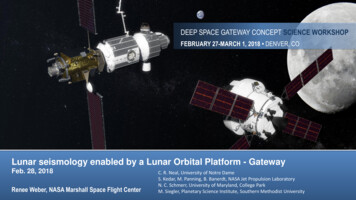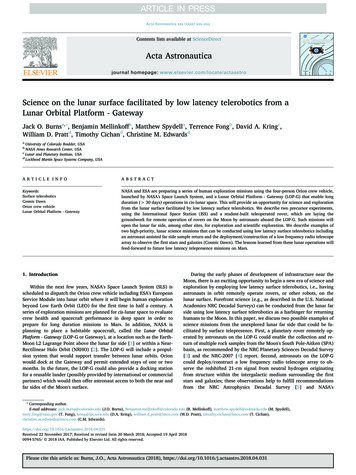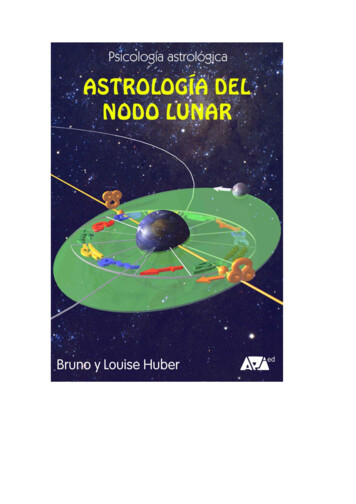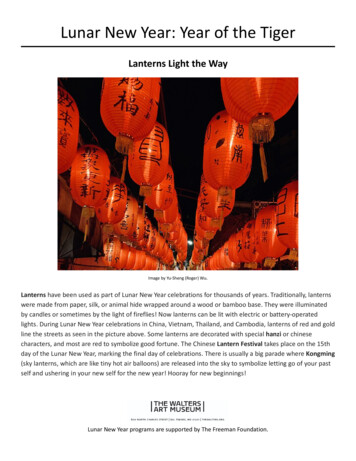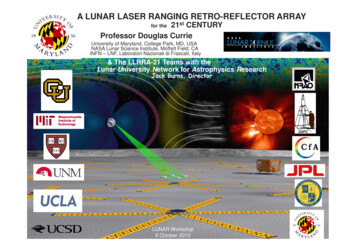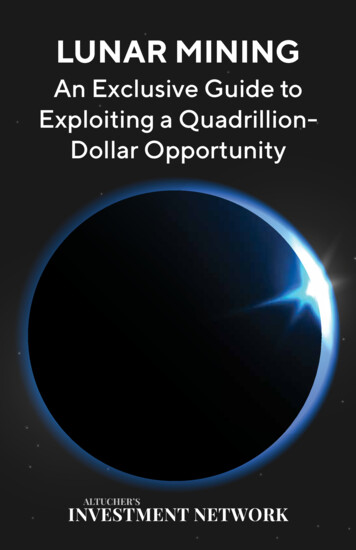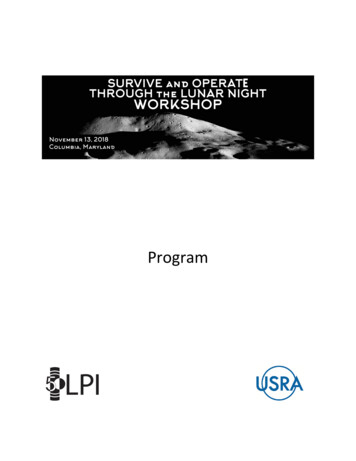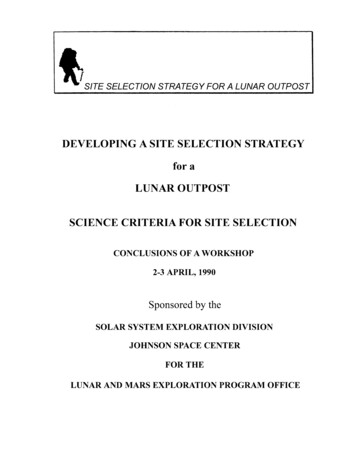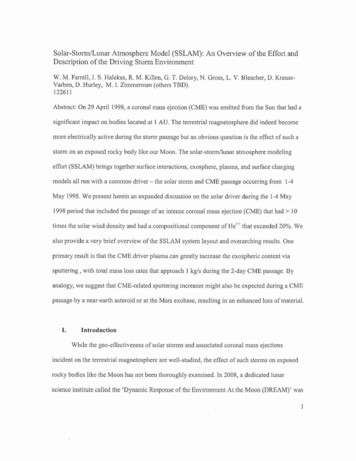
Transcription
CHAPTER 2Energy at the Lunar SurfaceIntroductionBy its nature a sediment or sedimentary rock represents expendedenergy. It is the product, t o a large degree, of its physical environment. Onthe earth's surface the physical environment of the planet is dominated bythe atmosphere and the hydrosphere both acting as intermediaries in thetransfer of solar energy for the breakdown and dispersal of sedimentarymaterials. The moon by contrast very obviously lacks both an atmosphereand a hydrosphere. This means that solar energy, which is by far the mostimportant energy source for the formation of terrestrial sediments, is almostcompletely ineffective in this role on the lunar surface. However, the absenceof an atmosphere and hydrosphere on the moon leaves the planetary surfacebared t o the interplanetary environment and kinetic energy in the form ofimpacting meteoroids. It also leaves other processes such as volcanism, massmovement and electrostatic processes unimpeded on rhe lunar surface.In this chapter the various potential energy sources are evaluated interms of their abilities t o erode or transport detrital materials on the lunarsurface. The significance of some energy sources, such as meteoroid flux, isobvious while others, such as the potential value of solar radiation, are muchdebated.The Meteoroid FluxThe surface of the moon is very obviously cratered and whether onesubscribes t o an impact or volcanic origin for the majority of the craters it isclear that meteoroid impact has played a major role in sculpturing the lunarsurface.The meteoroid cloud has a total mass of 2.5 x 10' 9 g within 3 . 5 AU ofthe sun and within an inclination of i 20" of the ecliptic (Whipple, 1967).This represents a total volume of 2.25 x 1041 cm3 . This cloud produces acontinuous rain of hypervelocity particles on the lunar surface. The rate atwhich energy is applied t o the lunar surface is small in terrestrial terms but
DISTRIBUTION O F METEOROIDSTauridso - Cetidsb - AquaridsArietidsFig. 2.1. Selected orbits of meteoroid streams.with the long periods of geologic time available it is a highly effectivemechanism for erosion and transportation on the lunar surface.Distribution of Meteoroids in SpaceTwo types of meteor populations can be distinguished according totheir spatial distribution; shower meteors ,and sporadic meteors (Dohnanyi,1970). Shower meteors move in highly correlated orbits and are distributedinto the volume of an elliptical doughnut with the sun in one of its foci (Fig.2.1). Close correlation between the orbit of a meteor shower and that of aknown comet has been established for a number of meteor showers, and it isbelieved that meteor showers originate from the partial disruption of comets(Whipple, 1963). Such disruptions occur when the comet is subjected to thethermal forces caused by the sun's radiation (Whipple, 1963).Sporadic meteoroids, on the other hand, move in random orbits and'fill up' the interplanetary space. The populations of sporadic and showermeteoroids are believed to be closely related (Jacchia, 1963). Sporadicmeteoroids may be shower meteoroids that have gone astray under theperturbing influence of the planets (Plavec, 1956).Two gravitational -dispersal processes can be distinguished for meteorstreams. One dispersal effect arises when particles are ejected from the cometnear perihelion with a relatively small and limited ejection velocity (Whipple,
DISTRIBUTION O F METEOROIDSHeliocentric Distance, A UII2345IIIIPioneer I I - 5 0 ,urn cellso Pioneer 10 - 2 5 ,urn cellsAsteroid Belt48-0oOOOO-Jupiter Encounter-ooOTime from Launch, DaysFig. 2.2. Time history of meteoroid penetrations detected by Pioneer 1 0 and 1 1 (from Humes et al.,1975, copyright 1975 by The American Association for the Advancement of Science).1950, 195 1). The result is a distribution of orbital elements for the particlesaround a mean value similar t o the orbital elements of the parent comet. Theparticles thus assume a spatial distribution of a cloud whose dimension isdefined by the spread in the orbital elements of the particles. However, withtime the distribution in the periods of the particles causes a gradual dispersalof the cloud along an orbit similar t o that of the parent comeT until theshower particles are confined into a doughnut-like region of space whoseshape is similar to the orbit of the parent comet.The second perturbing force acting on the meteor shower is theinfluence of planetary encounters. When a particle or group of particlesencounters a planet, they scatter into orbits that are quite different fromtheir initial orbits. The magnitude of the effect depends on the proximity ofthe encounter. The long-range statistical effect is that the particles willassume a distribution of orbits having an average inclination/eccentricityp t i o similar t o that of the sporadic meteors (McCrosky and Posen, 1961;'Opik, 1966).The most direct evidence for the distribution of meteoroids betweenthe earth and Jupiter has come from impact detectors on the Pioneer 10 and11 space probes (Humes et al., 1975) (Fig. 2.2). The distribution ofmeteoroids with masses less than 10-8 g is relatively constant out t o a
22DISTRIBUTION O F METEOROIDSdistance of almost 6 A.U. There is a slight increase in meteoroids between 1and 1.15 A.U. and a complete lack of meteoroids, or at least meteoroidpenetrations, between 1.15 and 2.3 A.U. There was no evidence of anincrease of the meteroid density in the asteroid belt which tends t o refuteany therory that the asteroids are the source of s'mall meteoroids. A highconcentration of meteoroids was encountered in the vicinity of Jupiter andis believed to be due t o gravitational focusing by this planet.Information on the population of meteoritic objects beyond the orbitof Jupiter is limited. However, estimates of the spatial distribution of radiometeors has given some insight into the overall distribution of meteoroids inthe solar system (Southworth, 1967b). The fraction of time each meteorspends in given regions of space was calculated and in combination withweighting factors yields an estimate for the spatial distribution (Fig. 2.3).The distribution is assumed t o be symmetric about an axis through theecliptic poles; there is a broad maximum in the ecliptic and a minimum atthe poles. The distribution of radio meteors is flatter than the one based onthe photometry of the zodiacal cloud (Fig. 2.3). Detection of fast meteors(those in highly eccentric orbits with large semimajor axes) is stronglyfavored by radar and, consequently, the emperical distribution of fastmeteors will be greatly exaggerated.0-IILog (Distance from Sun, Au)Fig. 2.3. Relative space densi'ty of radio meteors and of zodiacal particles as a function of theirdistance from the sun, and ecliptic latitude (from Dohnanyi, 1972).0
MEASURING THE METEOROID FLUXMeasuring the Meteoroid FluxA large volume of data is available for the mass distribution ofrnete roids.The data have been derived by a variety of methods, some earthbased, others using spacecraft and more recently lunar rocks. Consequently,the results and interpretations are frequently contradictory and a wideassortment of meteoritic models and fluxes has been suggested by various o r k e r s (Dohnanyi, 1970, 1972; Gault, et al., 1972; Kerridge, 1970;Soberman, 197 1, McDonnell, 1970).The mass distribution of micrometeoroids (particles smaller than lob6g) has been determined by a variety of methods. The first observation ofmicrometeoroids in the solar system was obtained by ground measurements.Observations of the solar K-corona (Allen, 1946) and the zodiacal light atgreater elongations (Van de Hulst, 1947) suggested that the two phenomenaarise from the scattering of sunlight by cosmic dust. A t the antisolar point,the brightness of the zodiacal cloud increases and forms a diffuse area ofcalled the gegenschein. The gegenschein appears t o result fromaboutthe backscatter of the sun's light by the zodiacal cloud (Siedentopf, 1955)although there are other views (Roosen, 1970) which suggest that thegegenschein is due to a particle concentration in the asteroidal belt orbeyond.With the coming of the space program a number of different detectorsbased on particle penetrations were flown on spacecraft (Fechtig, 1971 andDohnanyi, 1972 give reviews). These detectors have the advantage of makingdirect measurements of the properties of individual micrometeoroids andtherefore provide much more detailed information than can be obtainedoptically from the zodiacal cloud. The results of penetration measurementsare of considerable importance because they provide the only directmeasurements of micrometeoroids. Pressurized can detectors were used onsome Explorer and Lunar Orbiter satellites. The Ariel satellites used a thinaluminum foil detector which permitted the passage of light through holesproduced by micrometeoroid impacts (Jennison et al., 1967). Capacitordetectors were used on some Pegasus and Pioneer satellites. These detectorsare momentarily discharged by impact ionization as the micrometeoroidpenetrates the detector. Other Pioneer satellites had two parallel detectingsurfaces which allowed the determination of velocity and direction ofmotion and allowed the calculation of orbital parameters. These Pioneerdetectors were also backed with a microphone which detects the momentumof the events.A certain amount of information concerning the micrometeoroid flux isavailable from more direct evidence. For example, possible meteoritic
24MEASURING THE METEOROID FLUXparticles have been collected by rockets and balloons in the upperatmosphere (Farlow and Ferry, 1971). Information is also available fromdeep ocean sediments and particulate material in polar ice. Information fromthese sources is much more difficult t o interpret as it is never clear as towhat fraction of the particulates is extraterrestrial. More promising perhapsis the use of trace element chemistry to estimate the extraterrestrialcontribution t o deep ocean sediments (Baker and Anders, 1968). Similarly,several flux estimates are available from trace element studies of lunar soils(Ganapathy et al., 1970a, 1970b; Keays et al., 1970; Hinners, 1971). Theseestimates are discussed in more detail in a following section dealing with theavailability of meteoritic energy at the lunar surface; they providi littleinformation on the mass distribution of the meteoritic particles.The surfaces of most lunar rocks are densely pitted by micrometeoroidimpacts. These pits, most of which are glass lined, range in size up t o theorder of millimeters and provide very direct data on the mass distribution ofmicrometeoroids (Hb'rz et al., 197 1; Hartung et al., 197 1 , 1972 ; Gault et al.,1972). At least 95 per cent of the observed pits were the product ofmicrometeoroids impacting at velocities in excess of 1 0 km sec-1 (Hb'rz etal., 1971). Some rocks have an equilibrium distribution of craters (Marcus,1970; Gault, 1970) but younger glass surfaces of impact melt are notsaturated. Similar but smaller estimates of the present lunar flux wereobtained by examining craters on the surface of parts of the Surveyor 111spacecraft returned from the moon by Apollo 12 (Cour-Palais et al., 197 1 ) .A variety of methods af greater and lesser reliability are available forlooking at the small end of the meteoroid mass distribution. In some ways itis easier t o study larger meteoroids simply because they are large, forexample, they frequently reach the earth's surface so we know much moreabout their chemistry than we do about micrometeoroids. However, arrivingat estimates of their pre-atmospheric mass distribution is considerably morecomplex largely because the observational methods are indirect and requiredifficult calibrations.Meteoroids entering the earth's atmosphere ionize the air molecules intheir path and create an ionized trail. Intensely ionized trails of longduration may be detected by radio equipment and are then called radiometeors. Determination of the distribution of radio meteors as a function ofmass and orbital elements is difficult because of selection effects and becauseof the uncertain relation between the mass of a radio meteor and itsobservable dynamic parameters. Because of selection effects, radar misses thefastest and slowest meteors. Fast meteors leave ionized trails at great heights(above 100 km) and the trail charge density may, at these altitudes, diffuseinto the background before detection. Slow meteors do not leave a
MEASURING THE METEOROID FLUXsufficiently high electron line density that can be detected. Consequently,radar favors the detection of meteors having an earth entry speed of about40 km s-1 ; selection effects inhibit the detection of meteors with appreciablydifferent velocities.Luminous trails produced by meteoroids entering the earth's atmosphere are bright enough to be photographed. These trails are produced bymeteoroids with masses on the order of milligrams or greater (Dohnanyi,1972). As with radio meteors the greatest difficulty in determining meteormasses relates to calibration problems and strong selection effects. Theluminous intensity of a meteor is proportional to the third power of itsvelocity over certain velocity ranges. Consequently there is a strongpreference for fast meteors t o be detected because of the higher relativeluminosity. Because of the uncertainties in calibration photometricdata providean order of magnitude approximation of themassdistribution(Jacchia and Whipple, 196 1; Hawkins andandPosen,1961; DohnanyiSouthworth,1958; McCrosky1972).Possibly one of the most promising means of determining the flux oflarger meteoroids is the use of the seismic stations established on the moonduring the Apollo missions (Latham e t al., 1969). The advantage of themethod is that essentially the whole moon is being used as a detector so thatit is possible to obtain large samples of relatively rare events. The method hasnot yet reached its full potential, once again because of calibrationdifficulties. Estimates of the flux using the short period component of theseismic data compared favourably with some earth-based observations, but itimplies a considerably higher flux than follows from analyses of long-periodlunar seismic data (Duennebier and Sutton, 1974; Latham e t al., 1972). Thediscrepancy is believed to lie in the uncertainty of coupling of impact energyto seismic waves.The asteroid belt lies in the region between the planets Mars and Jupiterat about 2.5 to 3.0 AU from the sun. Several thousand asteroids occur in thisdiffuse doughnut shaped region and are readily observed optically (Figure2.4). The asteroids are important t o the present discussion for two reasons.First, they provide us with information on the mass distribution of the largermeteoritic bodies (m 101 3 g) and second, they figure prominently in manymodels of the origin and evolution of the meteoroid flux.Attempts have been made to use lunar and terrestrial crater counts as ameans of measuring time and correlating cratered surfaces on an interplanetary basis (Shoemaker e t al., 1962). Counts of large craters in thecentral United States and on the Canadian shield were used t o determinecratering rates and hence the flux of large bodies. Numerous similar crater
26MASS-FREQUENCY DISTRIBUTIONYeR, Distance From Sun (AU)Fig. 2.4. Radial distribution of asteroids (from Dohnanyi, 1972).counts were made of surfaces of different age on the moon. With absoluteages now available for some lunar surfaces as a result of the Apollo programthe data will undoubtably lead to a considerable refinement of thelarge-body flux (Table 2.1 ).The Mass-Frequency DistributionThe array of available flux data is both complex and confusing. Inalmost all cases complex calibrations and corrections are required t o convertTABLE 2.1Determinations of post-mare terrestrial and lunar cratering rate (from Dohnanyi,k972).Number of craters of diameter l km(km2 109 years)MethodEarthMeteorite and asteroid observations21 x 10-45 to 23 x 10-4110 x 10-412 x 10-42 to 9 x 10-445 x 10-4Astrobleme counts i i central U.S.A.1 t o 10 x 10-40.5 t o 4 x 10-4Crater counts in Canadian shield1 to 15 x 10-40.4 to 6 x 10-4Moon-Best estimate12 x 10-45 x 10-4
MASS-FREQUENCY DISTRIBUTIONobservational data t o number-frequency equilvalents. In figures 2.5 and 2.6most of the available data are plottted and it can be seen that in some casesthere are differences of several orders of magnitude. A large number ofwriters have reviewed the literature dealing with the statistics of meteoroidmasses (Vedder, 1966 ; Whipple, 1967 ; Bandermann, 1969 ; Bandermann andSinger, 1969; Kerridge, 1970; Soberman, 197 1; McDonnell. 1970). Fewreviewers have, however, examined the data critically and attempted t oestablish a best estimate of the flux. The most recent attempt t o this end was r o v i d e dby Gault et al. (1972).All of the micrometeoroid data selected by Gault et al. (1972) wererequired t o fulfill three criteria (Kerridge, 1970). First, the original datamust have come from an experiment that gave a positive and unambiguoussignal of an event. Second, it was required that the experiment must haverecorded sufficient micrometeoroid events t o provide a statistically significant result. Third, the response and sensitivity of the sensors must have beencalibrated using hypervelocity impact facilities in order t o provide, as far aspossible, a simulation of micrometeoroid events. Only 10 data points fromCrater Diameter / Particle Mass CalibrationD 7.m11265(cm)(p 3g cm3, v 2 0 k m s-1)OGO II,IP:.)r OGOmOHEOS 2A PIONEER 8t MARINER IPH Earth Orbiting Station SALYUT,0 MARINER 11VEXPLORERXXIE0 EXPLQRER XXI\PEGASUSr,n,m MOON, Prehistoric RParticle Mass m ( g )Fig. 2.5. Comparison of lunar and satellite micrometeoroid flux data (after H6rz et al., 1973).
MASS-FREQUENCY DISTRIBUTIONFig. 2 . 6 . Cumulative flux (mm2sec-I12 f l sterad) of meteoroids and related objects into Earth'satmosphere having a mass of Mp(g) or greater (after Dohnanyi, 1972).I
MASS-FREQUENCY DISTRIBUTIONexperiments meet all of the requirements (Fig. 2.7).For larger particles with masses between 10-6 and l g Gault et al. (1972)found that recent analyses of photographic meteor data (Naumann, 1966,Lindblad, 1967; Erickson, 1968; Dalton, 1969; Dohnanyi, 1970, 1972) agreeclosely with the earlier NASA model (Cour-Palais, 1969). After modificationfor the lunar environment the NASA model was adopted. For masses greaterthan 1 g Hawkins (1963) earlier model was adopted. The Hawkins model isin disagreement with the model based on long-period seismic data (Lathamet al., 197 1). However, as pointed out previously, there appear to be seriouscalibration problems associated with the seismic model.Fig. 2.7. The micrometeoroid flux measurements from spacecraft experiments which were selected t odefine the mass-flux distribution. Also shown is the incremental mass flux contained within eachdecade of mp (after Gault e t al., 1972, Proc. 3rd Lunar Sci. Conf., Suppl. 3, Vol. 3, MITIPergamon).
VELOCITY DISTRIBUTIONThe mass distribution for the lunar meteoritic flux of N particles (percm-2 106 yr-1 2n strd-1 ) of mass Mp (g) according to the model is:for particles with a density of 1 g cm-3 impacting with a root-mean-squarevelocity of 20 km s-l . The use of two exponential expressions with aresultant discontinuity is artificial but was introduced for simplicity. Alsoshown in Figure 2.7 is the incremental mass flux in each decade of particlemass, which shows quite clearly that most of the mass of materials impactingon the lunar surfacqconsists of particles of the order of 10-6g.Velocity DistributionThe velocity distribution of meteoroids is bounded on the lower side bythe escape velocity of the earth and on the upper side by the escape velocityof the solar system (Figure 2.8). The modal velocity of the distribution isapproximately 20 km s-1. This last figure is generally accepted as theroot-mean-square velocity for meteoroids (Gault et a[., 1972). Particlesimpacting the moon may have velocities as low as 2.4 km s-1 (the lunarescape velocity) but the mean is expected to be closer to 20 km s-1 becauseof the relatively lower effective cross section of the moon for slowerparticles. The velocity-frequency distribution is noticeably skewed towardsthe higher velocities with a secondary mode near the escape velocity for thesolar system. The secondary mode undoubtably reflects meteoroids with acometary origin. The distribution in Figure 2.8 is based on radio and photometeors, however, the curve is generally consistent with inflight velocitymeasurements of micron-size particles (Berg and Gerloff, 1970; Berg andRichardson, 197 1).Physical PropertiesDensityA search of the literature produces a large number of values of themean density of the meteoroid flux. Most, however, are just estimates andhave frequently been made t o satisfy the needs of the particular study. Aconsiderable body of information is also available for terrestrial falls.
PHYSICAL PROPERTIESEscape VelocitiesVelocity, km e c - IFig. 2.8. Velocity frequency distribution of meteoroids in relation t o t h e relevant escape velocities(after Hartung e t al., 1972, Proc. 3rd Lunar Sci. Conf.,Suppl. 3 , V o l . 3, MITIPergamon).Unfortunately, the survival of a meteorite during entry into the earth'satmosphere as well as its chances of being found is very dependent upon itscomposition. For example, iron and stony meteorites are much more likelyto survive than carbonaceous meteorites or meteorites with a high gascontent. Because density is also composition dependent it is difficult toassess the statistics of this information. Information from terrestrial findsdoes, however, suggest that the iron meteorites provide a useful figure for anupper density limit approximately 8 g cm-3. Much of the experimental worksuggested that micrometeoroids were "fluffy" and thus of very low density(eg. 1 g cm-3) (Soberman, 1971). The geometry of microcraters on lunarrocks has been analysed and compared with experimental data to extractinformation on particle density. The ratio of the maximum crater depthbelow the original uncratered surface to the mean diameter of the pit rim is afunction of particle density and velocity or impact (Fig. 2.9). The data arecompletely inconsistent with micrometeoroid densities being less than unityand suggest that very few particles have the density of iron (Hijrz et al.,1973). If it is assumed that the root-mean-square velocity of meteoroids is20 km s-1 most meteoroids must have densities between 2 and 4 g cm-3.Approximately 10 per cent of the microcrater population on lunar rocksurfaces appear to be different. Some of these microcraters have no glasslining which has been interpreted by some to suggest that they are produced
PHYSICAL PROPERTIESIIIIr1 1 1 1 1I10Impact Velocity (km sec-I)I111111100Fig. 2.9. Experimentally determined depth/diameter ratios using projectiles with densities from 1 to7.3 g cm73 and impact velocities from 3 to 13 km sec-l. The inserted histogram on'the lunardepth/diameters is based on 70 craters; an empirical curve accounting for the oblique impact isindicated (from H'drz et al., 1973).by low velocity impacts - possibly secondary events. However, there isevidence to suggest that the craters were initially glass lined and the glass hasbeen spalled off. Possibly more important is another rare type of craterwhich has been called a multiple pit crater (Hb'rz et al., 1973). Thesemicrocraters are produced by aggregate structures with a low density andnon-homogenous mass distribution.ShapeDirect observation of the shape of meteorites provides little usefulinformation. Mason (1962) presents photographs of a variety of meteoriteshapes, however, most were determined by ablation during entry into earth'satmosphere and later by weathering on the gfound. However, cratersymmetry is determined to a large extent by the shape of the projectile andits angle of incidence (Mandeville and Vedder, 1971; Kerridge and Vedder,1972; Mandeville and Vedder, 1973). Most noncircular microcraters on lunarrocks are elongate and shallow which indicates that they were produced byan oblique impact rather that by irregularly shaped micrometeoroids (Wdrzet al., 1973). Thus highly nonspherical micrometeoroids such as rods orplatelets are very unlikely. If the particles are modeled as prolate elipsoids
PHYSICAL PROPERTIES33he ratio a/b is less than 2. As mentioned in the preceding section, multiplepit craters suggest that a small number of micrometeoroids may have beencomplex aggregate particles.Chemical CompositionThe chemistry of terrestrial meteorite finds is well documented innumerous publications (eg. Mason, 197 1) and is beyond the scope of thepresent book. Because of the atmospheric entry conditions, weathering ath e earth's surface and the unknown statistical parameters connected withthe finding of meteorites, an estimate of the bulk chemistry of the flux onh e basis of terrestrial finds is at best difficult.Three types of meteroitic material could be expected on the moon(Anders et a/., 197 3) :1. Micrometeoroids and small meteoroids in the soil.2. Crater forming bodies in ray material and other ejecta.3. Planetesimals from the early intense bombardment of themoon in ancient breccias and highland soils.Few meteoritic particles survive a hypervelocity impact. Consequently astudy of the chemistry of meteoritic materials on the moon must be basedon the bulk properties of lunar rocks and soils in relation to elements whichare distinctive of meteoritic materials. Originally, it appeared the siderophileelements (Ir, Au, Re, Ni, etc.) would be the most reliable indicators ofmeteoritic material (Anders et al., 1973). Because they concentrate in metalphases during planetary melting, they are strongly depleted on the surfacesof differentiated planets (e.g. by a factor of 10-4 on Earth). Accordingly,they had been used as indicators of meteoritic material in oceanic sedimentsand polar ice (Barker and Anders, 1968; Hanappe et al., 1968). However, anumber of volatile elements (Ag, Bi, Br, Cd, Ge, Pb, Sb, Se, Te, Zn) turnedout to be so strongly depleted on the lunar surface that it became possible touse some of them as subsidiary indicator of meteoritic matter.Micrometeoroid CompositionAll lunar soils are enriched in meteoritic indicators-elements compared t o their crystalline source rocks. However, because of lateral mixingnot all of this enrichment can be attributed t o meteoritic materials. Mostsoils contain at least small amounts of exotic rock types which are not foundamong the large rock fragments collected at the site. Most important are thealkali rich (granitic and noritic) rocks which result in the soils being enriched
PHYSICAL PROPERTIESI" e t e o r i c "Elements In Mare SoilApollo 15: 15081 and 15501- Apol lo l I: 10084 (6x1Apol lo 12: 12028(3x)I-Luna 16IIrRe-VolatilesFig.' 2.10. All mare soils studied t o date are enriched in 'meteoritic' elements, relative to crystallinerocks. Net meteoritic component is obtained by subtracting an indigenous lunar contribution,estimated from crystalline rocks. Numbers above histogram indicate signal-to-noise ratio (i.e. ratio ofnet component t o correction). Abundance pattern is flat, with siderophiles and volatiles almostequally abundant. Apparently the meteoritic component has a primitive composition (cf. Fig. 2.11)(from Anders et al., 1973).in alkalis, uranium and thorium. After correcting for this enrichment Anderset al. (1973) found that the soil at the four sites examined all showessentially the same picture, with siderophiles enriched to 1.5-2 per cent C1chondrite equivalent and volatiles enriched to a similar if more variableextent. In figure 2.10 the data are normalized to C1 chondrites to permitcharacterization of the meteoritic component. The abundance patt- r isn flatwith siderophile and volatile elements almost equally abundant. This patternrules out all fractionated meteoroid classes when compared to the right sideof Figure 2.1 1. Ordinary chondrites, E5-6 chondrites, irons, and stony ironsare too deficient in volatiles (especially Bi) relative to siderophiles, whereasachondrites are too low in siderophiles. The attention is then focused onprimitive meteorites on the left side of the figure in which all siderophilesand volatiles occur in comparable abundances. A weak trend in the Apollodata suggests a slight depletion of volatiles that may be due to a small
PHYSICAL PROPERTIESrloMeteoritesIprimitiveFig. 2.1 1. Primitive meteorites (left) contain siderophiles and volatiles in comparable abundance.Fractionated meteorites (right) are depleted in volatiles (from Anders e t al., 1973).admixture of fractionated material (Anders e t al., 1973). However, thedominant material appears t o be of C1 composition.Several workers have taken a different and somewhat less rewardingapproach t o the problem of micrometeoroid composition (Chao e t al., 1970;Bloch e t al., 1971 ; Schneider e t al., 1973). Glasses lining the pits ofmicrocraters were analyzed in an attempt t o detect exotic componentswhich could be identified as part of the original projectile. In general theresults of these studies have been negative. This has been interpreted t oindicate that most micrometeoroids are in large part silicates which is inagreement with the density estimates given by H'o'rz e t al. (1973) and withthe findings of Anders e t al. (197 3).PlanetesimalsThe older soils exposed incomplex diagnostic meteoriticet al., 1973) which suggestscompositionally different fromthe lunar highlands have a different and moreelement pattern than the mare soils (Andersthat the ancient meteoritic component isthe micrometeoroid component. The greatest
36PHYSICAL PROPERTIESdifficulty in dealing with the highland soils is estimating the correction forindigenous materials.Siderophile e
Energy at the Lunar Surface Introduction By its nature a sediment or sedimentary rock represents expended energy. It is the product, to a large degree, of its physical environment. . Observations of the solar K-corona (Allen, 1946) and the zodiacal light at greater elongations (Van de Hulst, 1947) suggested that the two phenomena


